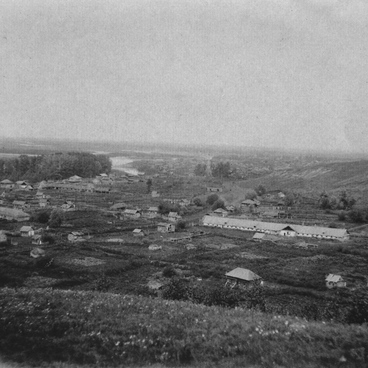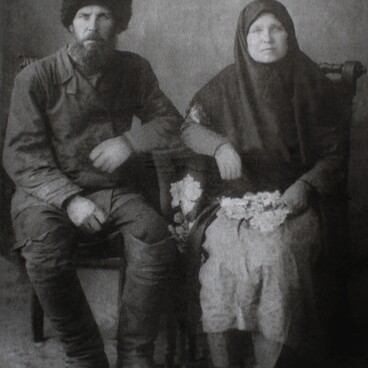This group photograph was taken by an unknown author in Srostki in the 1930s.
It shows the villagers near the Fordson wheeled tractor. This agricultural vehicle was forcibly confiscated from a wealthy family in the neighbouring village of Kokshi on the other side of Katun river. According to the memoirs, the tractor was delivered in May at midday, and the entire village gathered to look at it: people celebrated this event, rejoiced and smiled.
By this time, the Flame of Communism kolkhoz was established in the village, and Ivan Bespalov became its chairman. Tractor drivers Grigory Mazaev and Mikhail Kamenev were first to get behind the wheel of the Fordson. Then a rally was held, where Stepan Kuksin proclaimed: ‘A steel horse has arrived in Srostki, we are now entering a new life, an era of agricultural mechanisation. In the future, dozens of even more powerful and highly productive tractors and machines will come to us. They will support the landowner and liberate him from hard and exhausting manual labor’.
Eventually, the kolkhoz received several tractors of a domestic brand and a set of complementing agricultural tools. Nikolay Ivanov, Vasily Kolokolnikov, Stepan Protopopov, brothers Mikhail and Alexey Zhilkin became the first tractor drivers along with Kamenev and Mazayev.
Makar Shukshin, the father of Vasily Shukshin, joined the Flame of Communism in 1929. Before the revolution, Like many other old-timer Srostki residents, Shukshins lived in prosperity before the revolution, which was achieved by their hard work. They belonged to the traditional farmer family and specialised in growing grains.
On the night of March 24-25, 1933, more than 30 local residents, including kolkhoz workers, were arrested in connection with the Srostki Case. Among them were Shukshin, Kamenev, Kuksin, Mazaev, and Kolokolnikov — ordinary workers and village activists. Their sentence was carried out on April 28, 1933, in the Barnaul prison.
The photograph joined the museum collection in 1988. It was donated by Darya Faleyeva, an Honoured Worker of Culture of the RSFSR, Head of the Biysk Regional Library and founder of Vasily Shukshin Museum in Srostki. Researchers believed that Makar Shukshin, Vasily Shukshin’s father, was depicted in the photo.
It shows the villagers near the Fordson wheeled tractor. This agricultural vehicle was forcibly confiscated from a wealthy family in the neighbouring village of Kokshi on the other side of Katun river. According to the memoirs, the tractor was delivered in May at midday, and the entire village gathered to look at it: people celebrated this event, rejoiced and smiled.
By this time, the Flame of Communism kolkhoz was established in the village, and Ivan Bespalov became its chairman. Tractor drivers Grigory Mazaev and Mikhail Kamenev were first to get behind the wheel of the Fordson. Then a rally was held, where Stepan Kuksin proclaimed: ‘A steel horse has arrived in Srostki, we are now entering a new life, an era of agricultural mechanisation. In the future, dozens of even more powerful and highly productive tractors and machines will come to us. They will support the landowner and liberate him from hard and exhausting manual labor’.
Eventually, the kolkhoz received several tractors of a domestic brand and a set of complementing agricultural tools. Nikolay Ivanov, Vasily Kolokolnikov, Stepan Protopopov, brothers Mikhail and Alexey Zhilkin became the first tractor drivers along with Kamenev and Mazayev.
Makar Shukshin, the father of Vasily Shukshin, joined the Flame of Communism in 1929. Before the revolution, Like many other old-timer Srostki residents, Shukshins lived in prosperity before the revolution, which was achieved by their hard work. They belonged to the traditional farmer family and specialised in growing grains.
On the night of March 24-25, 1933, more than 30 local residents, including kolkhoz workers, were arrested in connection with the Srostki Case. Among them were Shukshin, Kamenev, Kuksin, Mazaev, and Kolokolnikov — ordinary workers and village activists. Their sentence was carried out on April 28, 1933, in the Barnaul prison.
The photograph joined the museum collection in 1988. It was donated by Darya Faleyeva, an Honoured Worker of Culture of the RSFSR, Head of the Biysk Regional Library and founder of Vasily Shukshin Museum in Srostki. Researchers believed that Makar Shukshin, Vasily Shukshin’s father, was depicted in the photo.

